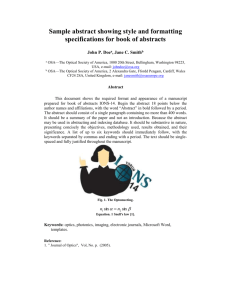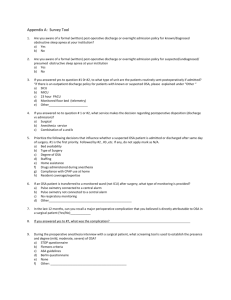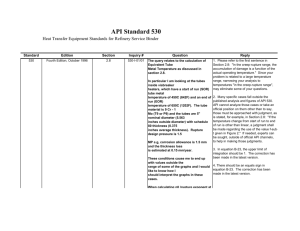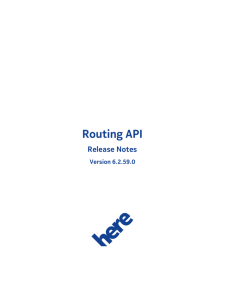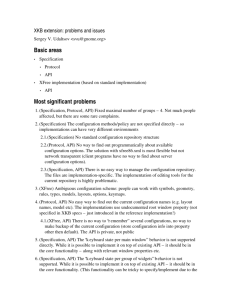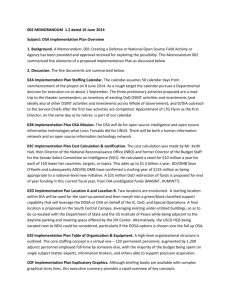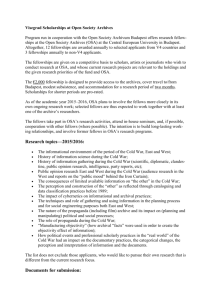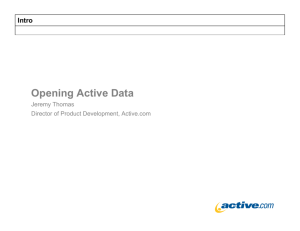n5-000006rev1
advertisement
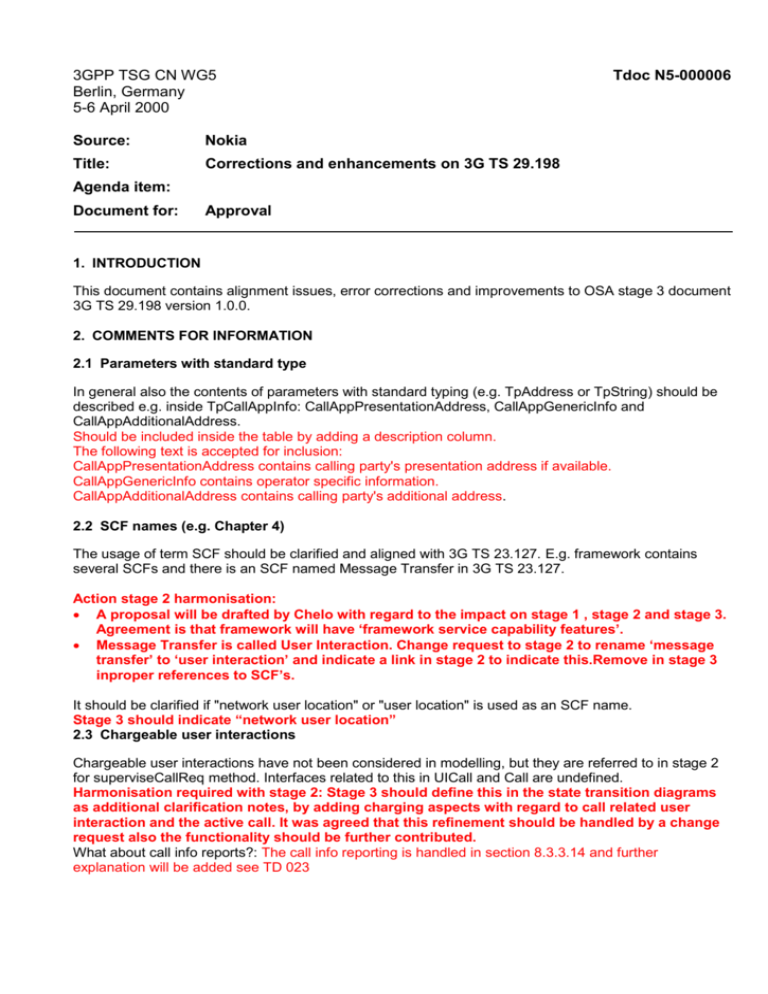
3GPP TSG CN WG5 Berlin, Germany 5-6 April 2000 Source: Nokia Title: Corrections and enhancements on 3G TS 29.198 Tdoc N5-000006 Agenda item: Document for: Approval 1. INTRODUCTION This document contains alignment issues, error corrections and improvements to OSA stage 3 document 3G TS 29.198 version 1.0.0. 2. COMMENTS FOR INFORMATION 2.1 Parameters with standard type In general also the contents of parameters with standard typing (e.g. TpAddress or TpString) should be described e.g. inside TpCallAppInfo: CallAppPresentationAddress, CallAppGenericInfo and CallAppAdditionalAddress. Should be included inside the table by adding a description column. The following text is accepted for inclusion: CallAppPresentationAddress contains calling party's presentation address if available. CallAppGenericInfo contains operator specific information. CallAppAdditionalAddress contains calling party's additional address. 2.2 SCF names (e.g. Chapter 4) The usage of term SCF should be clarified and aligned with 3G TS 23.127. E.g. framework contains several SCFs and there is an SCF named Message Transfer in 3G TS 23.127. Action stage 2 harmonisation: A proposal will be drafted by Chelo with regard to the impact on stage 1 , stage 2 and stage 3. Agreement is that framework will have ‘framework service capability features’. Message Transfer is called User Interaction. Change request to stage 2 to rename ‘message transfer’ to ‘user interaction’ and indicate a link in stage 2 to indicate this.Remove in stage 3 inproper references to SCF’s. It should be clarified if "network user location" or "user location" is used as an SCF name. Stage 3 should indicate “network user location” 2.3 Chargeable user interactions Chargeable user interactions have not been considered in modelling, but they are referred to in stage 2 for superviseCallReq method. Interfaces related to this in UICall and Call are undefined. Harmonisation required with stage 2: Stage 3 should define this in the state transition diagrams as additional clarification notes, by adding charging aspects with regard to call related user interaction and the active call. It was agreed that this refinement should be handled by a change request also the functionality should be further contributed. What about call info reports?: The call info reporting is handled in section 8.3.3.14 and further explanation will be added see TD 023 2.4 SMS and GPRS Functionality of the API regarding SMS and GPRS connectivity is undefined and out of the current scope as stated by S2. However superviseCallReq includes data volume parameter (bytes) at the moment. Alignment is needed. Will be part of the opens items. 2.5 Chapter 8.1.2.2 The tagged union typing is written to be implementation dependent. It is agreed to remove this sentence. 2.6 Chapter 8.3.3.27 TpCallReportType items need clarification. Defines a specific call event report type. Proposal that the mapping document resolves the abandon and calling and called party disconnect cases. Name Value Description P_CALL_REPORT_UNDEFINED 0 Undefined P_CALL_REPORT_PROGRESS 1 Call routing progress event: an indication from the network that progress has been made in routing the call to the requested call party. ??? will be calrified in the mapping document P_CALL_REPORT_ROUTING_SUCCESS 2 Call successfully routed to address: an indication from the network that the call has been routed to the requested call party. P_CALL_REPORT_ANSWER 3 Call answered at address P_CALL_REPORT_BUSY 4 Called party was busy P_CALL_REPORT_NO_ANSWER 5 No answer at called address P_CALL_REPORT_DISCONNECT 6 Call disconnect requested by called party. <What is the difference with P_CALL_REPORT_CALL_ENDED ?> P_CALL_REPORT_REDIRECTED 7 Call redirected to new address: an indication from the network that the call has been redirected to a new address. P_CALL_REPORT_SERVICE_CODE 8 Mid-call service code received P_CALL_REPORT_ROUTING_FAILURE 9 Call routing failed - rerouting is possible P_CALL_REPORT_CALL_ENDED 10 Call has ended (disconnected): an indication from the network that the call has been ended. “This could either be that the calling party or the called <???> party has disconnected’ should be deleted. P_CALL_REPORT_CALL_ABANDON ? further study 11 The call has been abondoned by the calling party required on this initial proposal. 3. MODIFICATIONS BY CHAPTERS 3.1 Chapter 1 agreed The stage 3 documentation of the OSA R’99 API consists of two parts: The API specification (Part 1). This is a normative stage 3 specification of the capabilities of the OSA R’99 API and describes the OSA API interface classes, containing class diagrams (see section 6), state transition diagrams (see section 7), SDLs (see section 8), data type definitions (section 9), and the IDLs (see section 10). The Mapping specification of the OSA R’99 API and the network protocols (Part2). This is an informative specification to provide an example how the OSA API can be mapped on the network protocols (i.e. MAP [7], CAP[8] and WAP[9]). It is an informative document, since this mapping is considered as implementation/vendor dependent. On the other hand this mapping will provide potential service designers with a better understanding of the relationship of the OSA API interface classes and the behavior of the network associated to these interface classes. The OSA API Stage 3 activity is performed jointly with ETSI SPAN3’s Service Provider Access Requirements activity. The contents of this document is related to the jointly owned 3GPP & ETSI document referred as the API Master document, which contains the API interface descriptions that are common and differentiated between ETSI & 3GPP. 3.2 Chapter 2 agreed [5] TS 22.101: ”Universal Mobile Telecommunications System (UMTS): Service Aspects; Service Principles” [8] TS 29.078: “3rd Generation Partnership Project; Technical Specification Core Network; CAMEL Phase 3, CAMEL Application Part (CAP) Specification” 3.3 Chapter 3.1 agreed User Profile: This is a label identifying a combination of one user interface profile, and one user services profile. 3.4 Chapter 6.3.1.3 agreed In method superviceCallRes TpSuperviseReport should be TpCallSuperviseReport as in the IDL. 3.5 Chapter 6.5 Body text says that "The Network User Location (NUL) service provides the IpUserLocationCamel and IpTriggeredUserLocationCAmel interfaces." As a matter of fact there is only one interface in the Network User Location service, IpUserLocationCamel. Same is valid also for the last sentence of the same chapter. So the chapter should be as follows; agreed "The Network User Location (NUL) service provides the IpUserLocationCamel interface, which provides methods for periodic and triggered location reporting. Most methods are asynchronous, in that they do not lock a thread into waiting whilst a transaction performs. In this way, the client machine can handle many more calls, than one that uses synchronous message calls. To handle responses and reports, the developer must implement IpAppUserLocationCamel interface to provide the callback mechanism." 3.6 Chapter 7.2.2 In figure 7-10 when going from state Outgoing Setup to Incoming also getCallInfoRes and superviseCallRes should be sent if requested. agreed ? In figure 7-10 when going from state Active to Incoming also superviseCallRes should be sent if requested. Agreed? Also section 8.3.3.31 should be updated if intermediate reports should be sent for follow on call, presently only P_Call_Supervise_Call_Ended is given, additionally also Call_Supervise_Call_Disconnect should also be defined? In figure 7-10 when going from state incoming to idle getCallInfoErr or superviseCallErr are not to be sent (see 23.127 and 29.998). Instead getCallInfoRes and superviseCallRes should be applied. Agreed? In Figure 7-11 "call ends" should be clarified and calling party abandons situations described consistently with figure 7-10. Abandon cases should be moved from 7-10 to 7-11. Refer to TD 23. 3.7 Chapter 7.3.1 In figure 7-12 userInteractionAborted is missing when going to null state:not Agreed should be added as a transition in the active state instead. The box on the right should be removed, because no reference to Call Control Manager is needed: Agreed. 3.8 Chapter 8.3.2.2 agreed see alsoTD23 In TpCallEventCriteria OriginatingLowerAddress should be changed to OriginationLowerAddress. 3.9 Chapter 8.5.4 agreed Chapter number should be 8.6. 3.10 Chapter 8.5.4.3 :not agreed could be indicated by TpMobilityError (8.5.2.8) as an additional error case e.g. as 7 : P_M_STATUS_NOT_PROVIDED, because it is seen as an error case? The following should be added to complete the functionality: P_NOT_PROVIDED 3 Network did not provide the status information.
